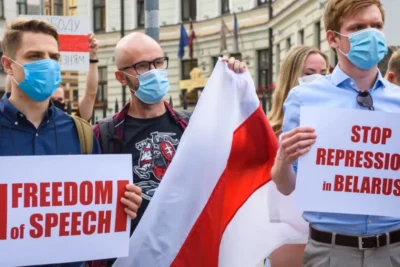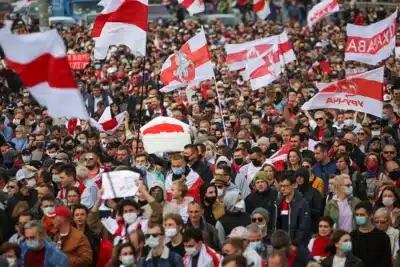
Why Belarus Is Called “Europe’s Last Dictatorship” in 2025

🧭 The Origin of the Label
The phrase “Europe’s last dictatorship” has become synonymous with Belarus since the early 2000s. Coined by Western media and echoed by international human rights organisations, this label is not simply rhetorical. It reflects the harsh political climate under President Alexander Lukashenko, who has ruled the country with an iron grip since 1994.
But what exactly makes Belarus a dictatorship? And why has it remained largely immune to the democratic reforms that transformed most of Europe after the Cold War?
Let’s explore the roots, mechanisms, and global implications of the dictatorship in Belarus.
🧱 The Rise of Alexander Lukashenko
In 1994, Belarus held its first and only relatively free presidential election. Alexander Lukashenko, a former collective farm director, won with populist promises to fight corruption and restore Soviet-era stability.
However, within a few years:
- He rewrote the Constitution via referendums.
- Term limits were abolished.
- All opposition media was shut down or taken over.
- The parliament was replaced with a rubber-stamp National Assembly.
Since then, Lukashenko has won every election with implausible margins — often above 80% — in votes marred by fraud allegations and international condemnation.
🗨️ “No one but Lukashenko can guarantee stability,” the regime proclaims. But at what cost?
🛑 Core Features of the Belarusian Dictatorship
To understand how the dictatorship in Belarus functions, we must look at its core tools of authoritarian control:
1. State Control of Media
All major TV stations, newspapers, and radio networks are controlled by the state. Independent journalism is punished:
- Reporters Without Borders ranks Belarus near the bottom for press freedom.
- Journalists are routinely arrested, fined, or exiled.
🔗 Related Post: Belarusian Partisans: From WWII Resistance to Digital Warriors
2. Secret Police and Surveillance
The KGB still operates under its Soviet name — a chilling reminder of its legacy. It is tasked with suppressing dissent, monitoring citizens, and arresting anyone deemed a “threat to stability.”
- Thousands have been detained during protests since 2020.
- Torture and inhumane conditions in detention centres have been documented by Amnesty International.
3. Fake Elections
Elections in Belarus are symbolic rituals rather than genuine contests. The regime:
- Controls the Central Election Commission
- Blocks opposition candidates from registering
- Alters ballots and intimidates voters
In 2020, mass protests erupted after Lukashenko claimed victory with 80%, widely seen as a fabrication. Opposition leader Sviatlana Tsikhanouskaya fled into exile under threat.
4. Cult of Personality
Lukashenko presents himself as:
- The “father of the nation”
- A man of the people who plays hockey and harvests potatoes
- The sole protector of Belarusian sovereignty
This narrative is reinforced daily in state media, turning politics into a performance of loyalty.
5. Silencing Civil Society
All NGOs must register with the government. Those that advocate for human rights or democracy are:
- Shut down
- Declared “foreign agents”
- Harassed by authorities
By 2023, over 500 civil organisations had been forcibly dissolved.
🌍 International Isolation (and Strategic Ties)
The dictatorship in Belarus has alienated itself from the West:
- The EU and U.S. imposed heavy sanctions post-2020.
- The regime has forged deeper ties with Vladimir Putin, becoming a de facto satellite of Russia.
Belarus has allowed Russian troops to launch attacks on Ukraine from its territory, further deepening its pariah status.
🔗 Related Post: Belarus' Role in the Russia-Ukraine Conflict
📱 Resistance in the Digital Age
Despite the repression, resistance persists. A new generation of cyber activists, underground journalists, and exiled opposition figures has taken the fight online.
Telegram channels like NEXTA, encrypted networks, and public leaks have kept hope alive. The dictatorship in Belarus may control the streets, but it struggles to dominate the cloud.
🕯️ Cultural and Psychological Impacts
Life under dictatorship breeds:
- Fear of surveillance
- Normalization of silence
- Internalised repression
Many Belarusians have grown up knowing nothing else. The regime’s goal is not just control — it’s obedience without question.
🛡️ Why “Europe’s Last Dictatorship” Still Stands
Unlike other post-Soviet states:
- Belarus never experienced a strong democratic opposition in the 1990s.
- Its economy remained state-controlled, avoiding the chaos of neoliberal reforms.
- Lukashenko’s propaganda was effective in promising “order vs chaos.”
But the cost has been decades of lost potential, international shame, and an entire generation growing up without freedom of expression.
🧭 Beyond the Label
Calling Belarus “Europe’s last dictatorship” is not hyperbole — it’s a political diagnosis. It reflects a regime rooted in fear, falsity, and force.
Yet the people of Belarus — especially the youth, exiles, and digital partisans — show signs of awakening.
Dictatorships don’t last forever. But they do require truth-tellers, memory-keepers, and those willing to resist.




